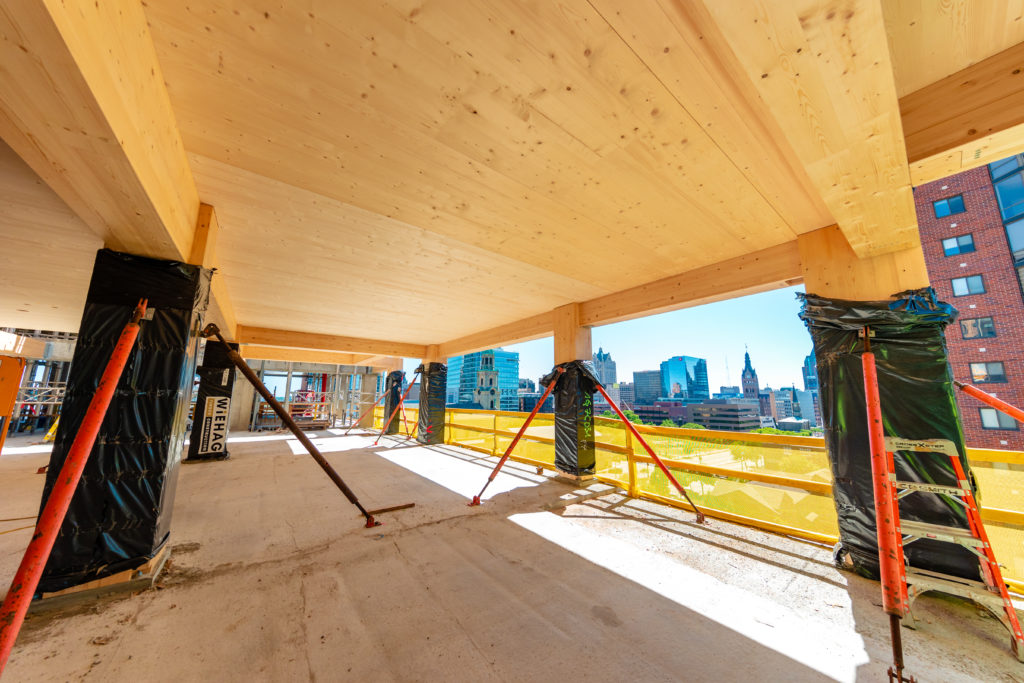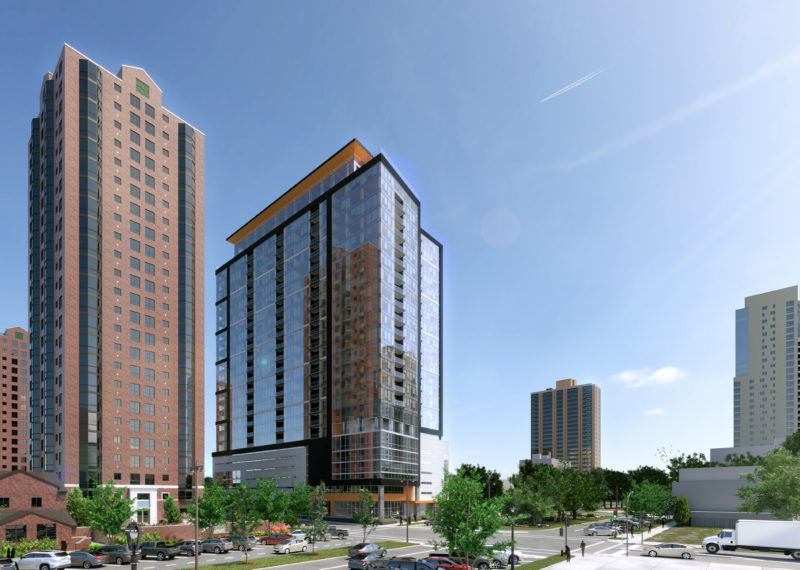When it opens up to tenants later this month, the Ascent, a 25-story, $125 million luxury high-rise in Milwaukee, Wisconsin, will offer an array of swanky amenities, including an indoor dog track and spa, electric car chargers and a golf simulator.
But that’s not what animates architect Jason Korb, whose firm designed the 259-unit structure.
“This building sequesters enough CO2 [carbon dioxide] that it’s the equivalent of taking 2,400 cars off the road for a year,” said Korb, adding that the timber was sustainably sourced from rapid-growth forests in Austria.
At 284 feet, Ascent is the tallest mass-timber building in the world, edging out Norway’s 280-foot-tall Mjøstårnet tower. There are some 1,300 mass-timber buildings either constructed or in the works in the United States, according to WoodWorks, an industry group. That figure is expected to rise as more cities adapt their building codes in an effort to reduce building-related emissions.
Mass timber uses compressed layers of wood as columns, beams and slats, among other components. Those layers are binded by glue, creating a steel-like piece of wood known as cross-laminated timber (CLT).
The use of wood in large buildings was common practice before steel-frame and cement skyscrapers took over skylines in the late 19th century. The evolution of those structures and concerns over fires tossed wood-frame high rises into the burner.
That transition took a hefty toll on the environment. Buildings (their energy use and construction) account for about 39 percent of global CO2 emissions, according to the International Energy Agency. Almost one-third of those emissions come from construction and building materials, like cement.
Although there have been important advances in passive architecture and building structures that are more energy efficient, that still leaves the question of what to do with all that concrete and rebar once a building comes down.
That’s why the prospect of moving from concrete and steel to timber excites John Fernández, a professor of architecture at the Massachusetts Institute of Technology. “Timber is a natural and ideal long-term carbon storer,” he said, adding that unlike cement and steel, the wood in CLT can be biodegradable, depending on the particular glues and adhesives used, or can be repurposed.
Fernández said CLT buildings also offer better insulation and indoor air quality than steel and cement buildings, too, as many feature exposed wood walls that don’t need paint or additional finishing.
Timber for Ascent was shipped to the U.S. from Austria, a pioneer in mass timber production. (Though timber is a major industry in Wisconsin, CLT production in the U.S. is still in its nascent stages.) Logging, transporting and constructing timber all emit carbon, but Fernández said he believes the benefits of mass timber still outweigh those costs—assuming the timber is sourced responsibly. “The market will want to source wood from wherever, but it’s important that we protect our native forests,” he said. “This can be a win-win for everyone if it’s done right and done responsibly.”

Construction costs for Ascent were about $253 per square foot, according to a Nexus Media analysis. Cost comparisons between timber and steel and concrete building projects vary, but some studies indicate that wood construction is still pricier. A study published in 2021 in the Journal of Building Engineering estimated that the construction cost of timber building is about 6 percent higher than the modeled concrete building.
Tim Gokhman, whose firm New Land Enterprises developed the Milwaukee project, said the cost per square foot for the timber used for Ascent was $42, versus a likely cost of $37 per square foot for concrete. Some of those costs were offset, he said, by money saved by having a lighter foundation, a smaller labor force and using less drywall.
Cities in Northern Europe have been building with mass timber for two decades. Fernández said U.S. building codes lag behind. New York City, for example, only updated its building codes to allow for mass timber in buildings up to 85 feet (about six stories) last year.
Developers for Ascent ran into this issue. Korb said his office spent more than two years working with Milwaukee officials to design a building that fit into the city’s code.
“Their concerns were largely based around fire,” Korb said. “Most of the testing that we did—or that had been done and we used—was about fire safety.” Testing revealed what the developers already knew: CLT buildings have been shown to be fire-resistant.
Gokhman said he believed once developers and insurers become more familiar with CLT, more mass timber buildings will rise—and costs will fall. “Mass timber looks better, it’s faster to work with and more precise, it’s lighter, takes a smaller labor force to assemble, and of course, it’s environmentally friendly,” he said.
Fernández agreed. “Once contractors become experts in putting up large mass timber buildings and the market showcases them, there could be a major uptick in demand,” he said. Korb’s firm currently has a 12-story building in design for San Francisco and is finalizing details to build another in St. Louis.
Nexus Media News is an editorially independent, nonprofit news service covering climate change. Follow us @NexusMediaNews.


